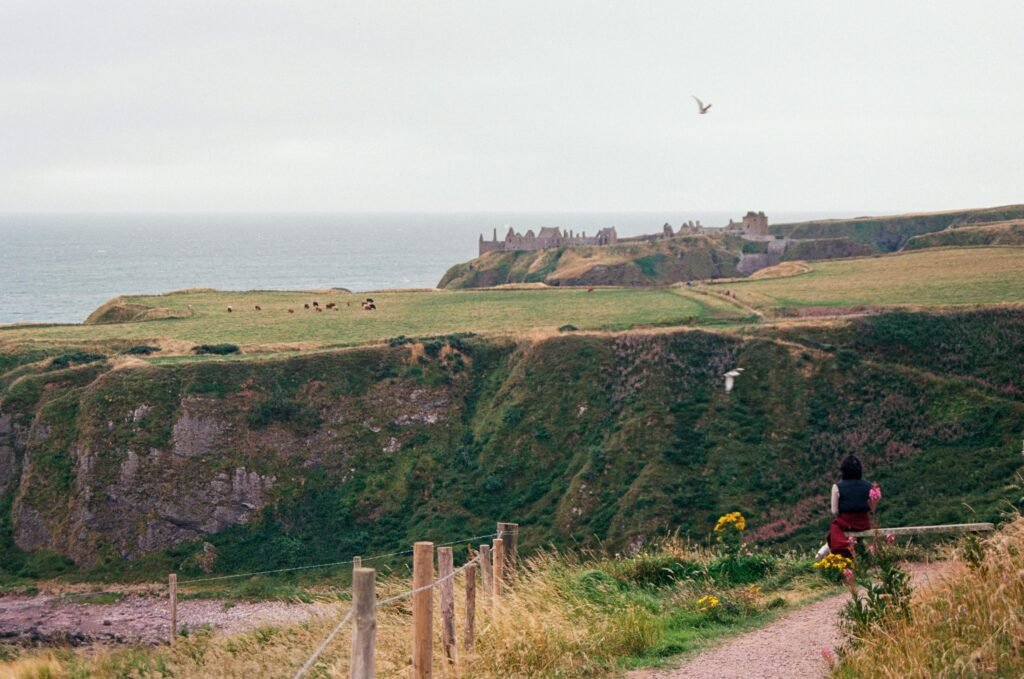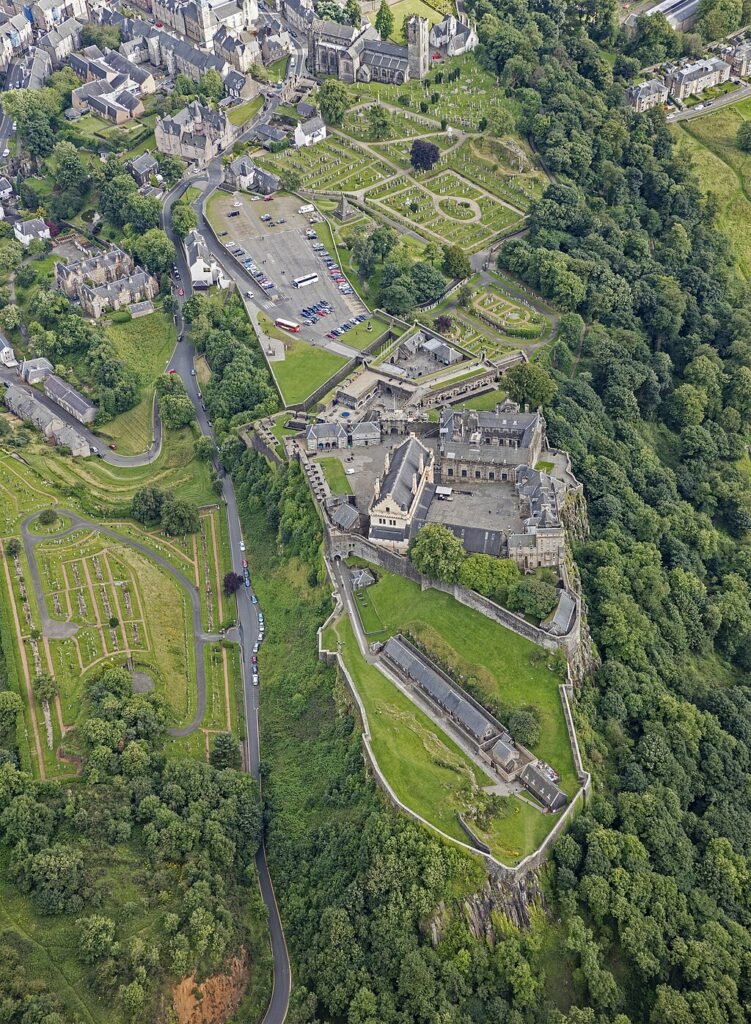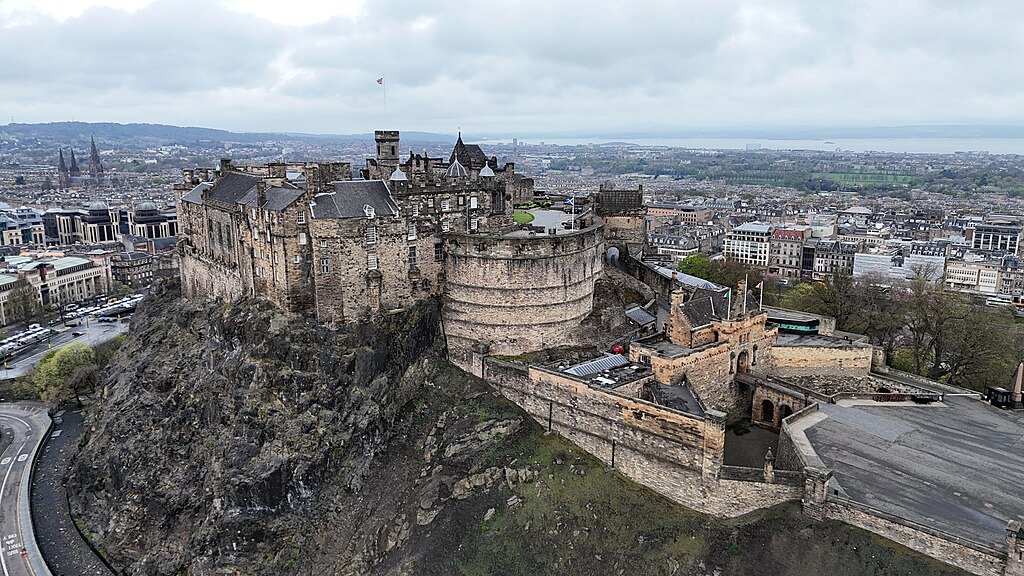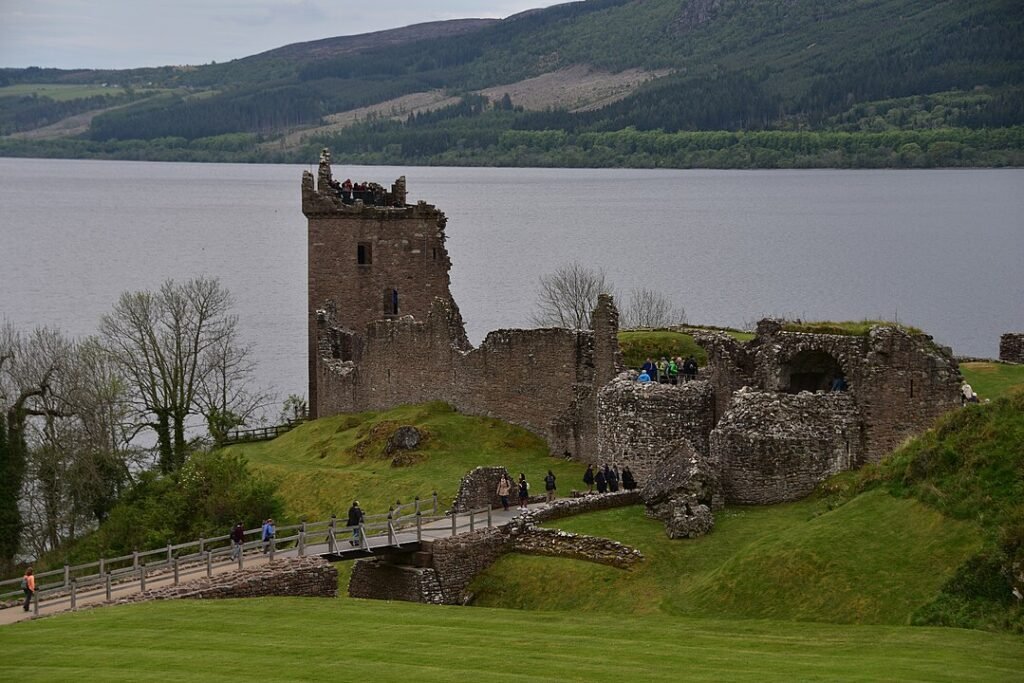
Dunnottar Castle: Perched on a rocky headland above the North Sea, Dunnottar Castle looks like it was chiselled straight from legend. A tumble of towers, halls and courtyards clings to a sea-battered promontory, separated from the mainland by a deep chasm and approached by a dramatic stairway. It’s the kind of place that stops you in your tracks. But Dunnottar isn’t just a pretty picture; it’s one of Scotland’s most storied strongholds, where rebels were imprisoned, royal regalia was smuggled to safety, and blockbuster films came for the atmosphere they just couldn’t fake.
This in-depth guide is written for UK and international visitors, families, couples and solo travellers who want clear, practical advice and a deeper sense of place. We’ll cover the history that shaped Dunnottar, how to plan your visit, where to walk, what to eat, where to stay, and how to expand your trip into a brilliant Aberdeenshire or broader UK itinerary.
Why Dunnottar Castle Belongs on Your Scotland Shortlist
Dunnottar sits two miles south of Stonehaven on Scotland’s north-east coast, its ruins arranged across a grassy headland roughly 160 feet above the sea. The approach alone is worth the journey: a cliff path undulates past wildflowers and seabirds before you descend a long flight of steps, cross the narrow neck of land and pass through a stout gate in the curtain wall. Inside, you can roam a 14th‑century tower house, 16th‑century “palace” ranges, a chapel and courtyards, each framing huge horizons of steel-blue water and ochre cliffs. On a bright evening, the stone glows honey‑gold; on a stormy day, it feels like the edge of the world.
What sets Dunnottar apart is the way its landscape does the storytelling. You sense immediately why this site mattered militarily (it commands the coastal approach), politically (it became a last redoubt when Scotland’s crown jewels needed hiding), and culturally (artists and filmmakers keep returning). Few places in Britain combine natural drama and human history as convincingly.
A Storied Past in Brief
Early power on the edge of the North Sea. The headland has seen centuries of activity, with references to sieges in the early medieval period. Over time, timber and earthworks gave way to stone fortification, and by the later Middle Ages, Dunnottar was a regional power centre.
The Keiths and the Earl Marischal. From the 14th century, the castle became the seat of the powerful Keith family, hereditary Earls Marischal. They expanded Dunnottar into an impressive complex with a tower house, great hall and later domestic ranges.
Saving the Honours of Scotland (1651–52). Dunnottar’s most famous chapter came during the Wars of the Three Kingdoms. As Cromwell advanced, Scotland’s Crown, Sceptre and Sword, the Honours of Scotland, were sent here for safekeeping. A blockade followed. In a feat of daring, the regalia were smuggled out and hidden in a nearby parish church until the Restoration. It’s no exaggeration to say Dunnottar and the brave locals who outwitted the besiegers helped save symbols of Scottish statehood.
Prison, forfeiture and romantic ruin. The late 17th century brought religious conflict, with Covenanter prisoners held in cramped cells. After the 1715 Jacobite Rising, the last Earl Marischal forfeited his titles and estates. Dunnottar fell into decline, becoming the picturesque ruin that captivates visitors today.
On screen. Directors love Dunnottar for obvious reasons. Its clifftop setting doubled for Elsinore in Hamlet (1990), and it later appeared in Victor Frankenstein (2015). If you feel a moment of déjà vu as you pass through the gatehouse, you probably saw it at the cinema first.
Fast Facts
- Location: 2 miles (3.2 km) south of Stonehaven, Aberdeenshire; postcode for the main car park: AB39 2TL.
- Setting: Ruined castle spread across a headland, accessed via long stairways and a narrow land bridge.
- Allow: 1.5–3 hours for the castle; more if you’re walking the coastal path.
- Who it suits:
- Families: Brilliant for adventurous kids with energy to tackle steps; not ideal for buggies.
- Couples: Wild scenery, golden-hour light and soul-stirring viewpoints.
- Solo travellers: Superb for coastal walking and photography; easy public transport links via Stonehaven.
- Accessibility: Steep steps and uneven surfaces make interior access challenging. Good views of the castle are possible from the cliff‑top path by the car park; ramps and lifts are not available on the headland itself.
- Dogs: Welcome on short leads; keep well back from cliff edges and be mindful of seabirds and livestock on the approach paths.
Planning Your Visit: Practicalities That Matter
Getting There
By car. From Aberdeen, take the A92 south (~30 minutes in normal traffic). The signed Dunnottar Castle Car Park sits above the cliffs; from here it’s a 10–15 minute downhill walk to the entrance, with a steep stair on the return. The car park includes blue‑badge bays. There are EV chargers in Stonehaven if you’re touring by electric vehicle.
By train + bus/on foot. Stonehaven is on the mainline; trains from Aberdeen take around 20 minutes and run frequently. From Stonehaven, you can:
- Walk the coastal path to the castle (around 45–60 minutes each way; allow longer with young children or lots of photo stops). The route undulates but is straightforward in dry conditions.
- Take a local bus towards the A92 (look for services that stop near Dunnottar Junction), then walk the remaining stretch to the car park and down to the castle. Schedules change seasonally; check times before you set out.
Guided day tours. If you’re short on time, several operators run day trips from Aberdeen (and occasionally from farther afield) combining Dunnottar with Aberdeenshire highlights.
Opening Times & Tickets
Dunnottar operates seasonal hours, with longer days in late spring and summer and shorter hours in winter; last entry is typically one hour before closing. The castle can close at short notice in severe weather, especially during high winds or ice. Always check the official website or social feeds on the morning of your visit.
Tickets are available on site at the entrance. Pricing is modest compared to larger urban castles; families and students usually find good value. Contactless payment is widely accepted.
Accessibility Notes
- Expect long stairways and uneven, sometimes slippery steps; rain and sea spray add to the challenge. Sturdy footwear is essential.
- There is no lift access and limited seating inside the complex.
- For visitors who can’t manage the stairs, the cliff‑top viewpoints near the car park offer superb perspectives of the castle and coastline, with no charge to enjoy the views.
Family Friendliness
Dunnottar is an exhilarating outdoor classroom. Young historians can peek into the kitchens, run through grassy courtyards and imagine life in the tower house. That said:
- Buggies/pushchairs struggle on steps and narrow passages; a carrier is better for babies and toddlers.
- Keep children well back from cliff edges and hold hands on stairways.
- Pack layers: it’s often windier and cooler on the headland than in town.
Photography & Drones
The castle’s exterior is a dream to shoot in all seasons. Professional filming and commercial photography require advance permission. Consumer drone flying is not permitted during opening hours and is tightly controlled at all times; respect signage and local guidance. Golden hour (late afternoon/evening) often delivers the most flattering light.
Best Time to Visit
- Spring (April–May): Fresh greens on the headland, lively seas, and the start of seabird season. Shoulder‑season calm makes this a favourite for photographers.
- Summer (June–August): Long, light evenings and peak access, also the busiest period. Arrive at opening or after 4 pm to dodge tour groups.
- Autumn (September–October): Warm stone against bracken browns; changeable skies bring drama without peak‑season crowds.
- Winter (November–March): Atmospheric and quiet, but with short days and potential weather closures. Check updates before travelling.
What to See: Highlights Inside the Ruin
- The Gatehouse & Curtain Wall: The only landward approach funnels through a defensive cleft; pause to picture sieges and supply wagons grinding up the slope.
- Tower House (Keep): The medieval core with thick walls and cramped chambers – power and protection rolled into one.
- The “Palace” Range: 16th‑century domestic buildings where the Earls Marischal displayed their wealth; look for fireplaces and window seats framing North Sea horizons.
- Chapel & Grave Slabs: Quiet corners where stories from Dunnottar’s earliest days echo.
- The Whigs’ Vault: A sombre reminder of the Covenanter prisoners held here in 1685.
- The Headland Edge: Step carefully to signed viewpoints for unforgettable perspectives along the Aberdeenshire coast.
Walking the Coast: Routes You’ll Talk About for Years
Stonehaven Harbour to Dunnottar (there and back).
- Distance/Time: ~5–7 km return, 1.5–2.5 hours depending on pace and stops.
- Why go: A perfect “slow arrival”. You trace the coastline past the War Memorial on Black Hill, gaining cinematic views of the castle long before you reach it. Great for sunrise or golden hour.
Dunnottar to RSPB Fowlsheugh (for seabirds).
- Distance/Time: ~11–16 km return from Stonehaven (or ~6–8 km return from the castle), 3–5 hours total.
- Why go: In late spring and summer, the cliffs at Fowlsheugh are stacked with kittiwakes, guillemots and razorbills, with the chance of puffins and passing dolphins. A show‑stopping add‑on for wildlife lovers.
Short family amble from the car park.
- Distance/Time: 1–2 km, 30–60 minutes round trip to the viewpoints.
- Why go: If you’re visiting with young children or grandparents, this offers the essence of Dunnottar – big views, sea air, without all the stairs.
Safety notes for all routes: Cliffs are unfenced; keep to signed paths, take it slowly in wind or rain, and wear sturdy shoes. If sea haar (coastal fog) rolls in, turn back rather than pushing on in reduced visibility.
Suggested Itineraries
1) One Perfect Day: Aberdeen & Dunnottar
Morning – Train from Aberdeen to Stonehaven (~20 minutes), then stroll through the harbour and up to the War Memorial for your first wide view of the coast. Grab coffee and a pastry in town.
Late Morning – Walk the coastal path to Dunnottar Castle (45–60 minutes). Allow 90 minutes to 2 hours inside the castle to explore the gatehouse, tower house and palace range.
Lunch – Picnic on the cliffs (well away from edges), or head back to town for fish and chips on the beach.
Afternoon – If energy allows, continue south for an hour along the cliff path for different angles on Dunnottar, then wander back into Stonehaven for a swim at the heated Open Air Pool in season or a harbour‑side pint.
Evening – Train back to Aberdeen for dinner and a night in the city or stay in Stonehaven to watch the last light catch the castle walls.
For families: Swap the longer walk for the car park approach. Time your castle visit for mid‑morning when kids are fresh, then reward everyone with ice cream on the harbour.
2) A Weekend in Stonehaven & Royal Deeside (2–3 Days)
Day 1 – Dunnottar deep‑dive. Arrive in Stonehaven, settle into your hotel, then spend the afternoon at the castle. Take the clifftop viewpoints, both north and south, for varying perspectives.
Day 2 – Castles & gardens inland. Drive 35–45 minutes to Crathes Castle (historic tower, beautiful walled gardens and a superb adventure play area) and Drum Castle (a layered castle story from medieval tower to Victorian mansion with a rose garden and woodland trails). Both are excellent for families, with cafés and facilities.
Day 3 – Coast & wildlife. Choose between a second sunrise at Dunnottar, a seabird day at RSPB Fowlsheugh, or a leisurely coastal drive north past Aberdeen’s beaches. If you’re visiting in July, check for Stonehaven Folk Festival concerts or the Highland Games.
For couples: Book a late‑afternoon slot at Dunnottar, then linger on the cliff paths for golden‑hour photos before a seafood dinner on the harbour.
3) Aberdeenshire Castle Trail Sampler (3 Days by Car)
Day 1 – Stonehaven to Alford (via Dunnottar). Morning at Dunnottar, lunch in Stonehaven. Head inland to Craigievar Castle (the rosy‑hued “fairytale” tower; check seasonal opening), then overnight near Alford or Banchory.
Day 2 – Royal Deeside. Explore Crathes and Drum with time for garden walks and a café pause. Detour to the Victorian village of Ballater or a forest stroll in Glen Tanar.
Day 3 – Northern gems. Drive to Fyvie (baronial grandeur and art) or Haddo House (parkland and architecture). Loop back to Stonehaven or Aberdeen.
Driving notes: Distances are modest, but roads are scenic and often single‑carriageway – build in time. Use brown Castle Trail signs as a handy wayfinding aid.
4) Coastal Castles Road Trip (2–4 Days, Scotland to England & NI)
If Dunnottar sparks a taste for sea‑battered strongholds, combine it with:
- Tantallon Castle (East Lothian): A cliff‑edge giant facing Bass Rock – vast curtain wall, epic views.
- Dunstanburgh & Bamburgh (Northumberland): A ruin you reach on foot along the shore (Dunstanburgh), paired with Bamburgh’s grand fortress and vast beach.
- Dunluce Castle (Northern Ireland): Another dramatic promontory ruin above the Antrim coast – combine with the Causeway Coastal Route.
This cross‑border loop weaves together some of the UK’s most photogenic coastal fortresses while keeping driving times reasonable between overnight stops.
Eating & Drinking: From Harbour Classics to Highland Comforts
In Stonehaven
- The Bay Fish & Chips (beachfront): A North‑Sea‑fresh, sustainably‑minded chippy – best enjoyed on the promenade when the gulls behave.
- The Tolbooth Seafood Restaurant (harbour): Refined, seasonal plates and a proper sense of place – ideal for a celebratory dinner.
- The Marine Hotel (harbour): Craft beers and hearty fare with sea views; good for groups.
- Cafés & coffee: You’ll find solid options in town for pastries and takeaway sandwiches to fuel a coastal walk.
Around the region
- Aberdeen (30 minutes north) offers everything from relaxed seafood shacks to white‑tablecloth dining – use it as a culinary base if you prefer city stays.
Dietary notes: Vegetarian and gluten‑free options are increasingly common; seaside towns can be busy at weekends in summer, so book for dinner if you have your heart set on a particular place.
Where to Stay: A Place for Every Traveller
Harbourside character (romantic or social):
- The Ship Inn – Historic inn right on the quay; rooms with harbour views and a buzzy bar downstairs.
- The Marine Hotel – Restaurant with rooms overlooking the boats; ideal for food‑first travellers.
Town‑centre convenience (good for families):
- Number 44 Hotel & Bar – Central and practical for trains, buses and beach days.
Small B&Bs and guesthouses (good value):
- Bayview B&B, Arduthie House and other independents offer friendly service and hearty breakfasts – ideal for walkers.
Rural retreats (for quiet nights):
- Farm stays and stone cottages south of Stonehaven give you starry skies, easy parking and short drives to Dunnottar at sunrise.
Aberdeen city base (for wider touring):
- If you’re combining work and leisure or want more evening choice, stay in the city and day‑trip down the coast.
Booking tips: Summer fills fast, reserve early for July/August weekends, festival dates and school holidays. Many properties have limited parking; check in advance if you’re road‑tripping.
Seasonal Events & Special Experiences
- Stonehaven Fireballs (Hogmanay, 31 December): A midnight procession of locals swinging blazing baskets – Scotland’s winter festivals don’t get much more elemental. Roads close and crowds are large; arrive early and dress warm.
- Stonehaven Folk Festival (mid‑July): Concerts, sessions and the legendary Aqua Ceilidh at the heated Open Air Pool – a joyous weekend for music lovers.
- Stonehaven Highland Games (July): Pipes, caber‑tossing, dancing and family‑friendly spectacle.
- RSPB Fowlsheugh (late spring–summer): Cliff‑nesting seabirds in vast numbers – pair with Dunnottar for a day of wildlife and history.
- Stonehaven Open Air Pool (late May–early September): A heated, Art‑Deco lido; look out for evening “starlight” or “midnight” swims.
Tips for the Best Photos
- Classic angles: From the approach path north of the castle; from the car park viewpoints; and from the path south towards the next bay.
- Time of day: Late afternoon to sunset paints the stone warm and picks out textures; dawn gives you calm seas and empty frames.
- Lenses: A wide‑angle for dramatic foregrounds on the cliff path, and a short telephoto to compress waves and walls.
- Respect the site: Stay behind barriers, keep drones grounded during opening hours, and never step beyond fenced areas for a shot. The cliffs are unstable in places.
Beyond Dunnottar: Broader UK Travel Themes to Weave In
Heritage, alive and well. Dunnottar is a springboard into Scotland’s castle culture: in Aberdeenshire alone, you can follow a signed Castle Trail linking 19 standout sites, from rose‑pink towers to baronial mansions. Across Britain, castles anchor journeys through national parks and along coastlines, think Tintagel in Cornwall with its dramatic footbridge, Tantallon near Edinburgh facing the Bass Rock, Bamburgh and Dunstanburgh along Northumberland’s wide sands, and Dunluce clinging to the cliffs of Antrim. Build your trip around fortresses and you’ll naturally discover great walking, wildlife, local food and film locations along the way.
Film & TV tourism. From Hamlet to Outlaw King, filmmakers come to the UK for landscapes that act like characters. Dunnottar’s screen pedigree pairs nicely with a visit to Bamburgh (the “Last Kingdom” castle of Bebbanburg) or Doune (famous from Monty Python and Outlander). If celluloid lures you to a place, use it as a gateway to the real stories beneath the surface.
Rail‑and‑walk escapes. The Aberdeen–Stonehaven line makes Dunnottar an easy car‑free day out. Extend the idea: Northumberland’s castles link neatly by bus and footpath; Cornwall’s coastal ruins pair with train rides and cliff walks; Northern Ireland’s Causeway Coast couples dramatic sites with frequent buses. Choosing one “anchor” castle and stringing together walks and local transport can turn a short break into a low‑stress, low‑carbon adventure.
Responsible Travel & Practical Advice
- Pack for the coast. Even in July, a windproof layer, hat and comfortable footwear make all the difference.
- Mind the cliffs. Keep children close, dogs on short leads, and never lean or climb beyond barriers.
- Weather & closures. High winds can close the site; check on the day you travel.
- Leave no trace. Take litter back to town and avoid disturbing nesting birds; coastal ecosystems are fragile.
- Support local. A coffee from an independent café, a seafood lunch in the harbour, a night in a family‑run B&B – small choices keep coastal communities thriving.
Sample Half‑Day & Full‑Day Time Plans
Half‑Day (Morning, with car)
- 09:00 – Park at Dunnottar. Walk to viewpoints for moody, wide‑angle shots.
- 09:30–11:00 – Explore the castle (allow 90 minutes).
- 11:00–11:45 – Stroll the cliff path south for additional perspectives.
- 12:15 – Drive back to Stonehaven for lunch on the harbour.
Full Day (Car‑free)
- 09:30 – Train to Stonehaven; coffee near the station.
- 10:15–11:15 – Walk the coast path to Dunnottar, photographing en route.
- 11:15–13:00 – Visit the castle (bring snacks; the headland is exposed).
- 13:00–15:00 – Continue south an hour or so for quieter viewpoints, or return to town for the Open Air Pool (in season).
- 15:30 – Ice cream on the promenade; train back to Aberdeen.
Nearby Add‑Ons You’ll Love
- Kinneff Old Church – A short drive south, visit the quiet kirk where the Honours of Scotland were hidden after their escape from Dunnottar.
- Stonehaven War Memorial (Black Hill) – A solemn hilltop temple with panoramic views; great at sunset.
- Dunnottar Woods – Sheltered woodland trails inland from the harbour; perfect if the coast is too windy.
- New Slains Castle (Cruden Bay) – A later coastal ruin that may have inspired Bram Stoker’s Dracula; a dramatic stop on a day north to the Buchan coast.
Frequently Asked Questions
How long should I spend at Dunnottar?
Most visitors are happy with 90 minutes to 2 hours inside the castle, plus extra time for the coastal walk and viewpoints.
Is it suitable for young children?
Yes – if they’re steady on steps and you keep them close to you. The sheer drops mean extra vigilance. Buggies aren’t practical beyond the car park path.
Can I bring my dog?
Yes, on a short lead. Be considerate around other visitors and wildlife.
Do I need to book?
Tickets are sold on site. In the height of summer, arriving early or later in the afternoon helps you avoid queues.
Where can I get the best photos?
The northern approach path, the southern cliff path beyond the entrance, and the car park viewpoints all offer classic angles. Late light is your friend.
Is there food at the castle?
Facilities are limited on the headland; bring water and snacks. Stonehaven has plenty of cafés, pubs and takeaways.
Final Thought
Dunnottar Castle distils Scotland’s appeal into one cliff‑top silhouette: history you can touch, a coast you can hear and smell, and views that lift you right out of everyday life. Come for the photo; stay for the stories. Then keep going, along the cliffs, inland to gardened towers, or south and north to more windswept ruins. If Scotland had a mood board, this would be front and centre.


